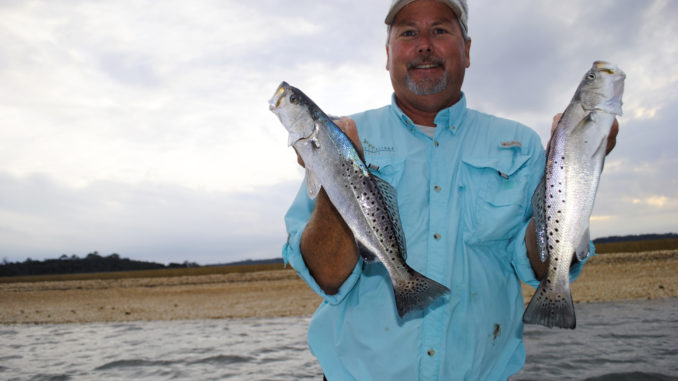
Real or plastic, shrimp are the ticket to catching speckled trout in the North Edisto in November.
On a steel-gray, November afternoon, Rob Bennett of Lowcountry Inshore Charters cruised the lower section of the North Edisto River, checking areas where he’d been catching speckled trout to see which one best fit the level of the rising tide.
He settled on a flat across the river and slightly downstream from the mouth of Leadenwah Creek, pointing to scattered oyster rocks and a current eddy near the mouth of a little drain creek.
Hooking a live shrimp on a popping cork rig, it only took Bennett a cast or two before he was fast to a nice keeper trout that struck in several feet of water, perhaps 50 feet off the bank. In the back of his boat, another angler quickly hooked up with another speck, this one hitting a soft-plastic bait threaded onto a jighead under a cork.
It didn’t take long until a dozen specks were resting in the cooler, with Bennett and his party laughing out loud every time another trout was fooled and yanked the cork under the surface.
Welcome to late-fall trout fishing on the North Edisto and its tributaries.
“We’ve caught some beautiful specks this year; I expect we’ll have tremendous trout fishing this fall,” said Bennett (843-367-3777). “We had such a mild winter last year, and those fish finished spawning in September and have started feeding again.
“By late October, the trout will be everywhere — in the river and in the creeks — and there will be shrimp all over the place until mid-November. The water temperature from about Oct. 15 until Thanksgiving will be in that 65- to 72-degree range that the trout love. Water around 68 degrees is like heaven to them. And when you find one, there will be more with that one.”
Bennett’s jumping-off point is the Cherry Point boat ramp in the village of Rockville, a mile or so upstream from the mouth of Bohicket Creek at the end of Maybank Highway. He’ll fish as far upstream in the river to Toogoodoo Creek, but he does most of his damage on the main river and — as the weather cools — in Toogoodoo, Steamboat, Leadenwah, Adams, Bohicket, Privateer and Ocella creeks. He makes an almost daily visit to at least one of those creeks to net live shrimp, which are his bread-and-butter baits.
“I like to go back in the creeks an hour before low tide and catch shrimp; it’s pretty easy,” he said. “You can catch ’em anywhere, and there will be plenty all the way to Thanksgiving — at least you can catch enough to fish with.”
When the water cools and the shrimp start to leave the river for the ocean, the fishing will actually get better for a couple of weeks as specks don’t have a ready made buffet line of crustaceans on which to feast and are a little more aggressive, especially to artificials.
Bennett’s tactics are fairly simple. Look in certain kinds of places for trout and fish as many of them as you can until you find a school — then work them over.
“Trout will be in the rivers and creeks, and I concentrate on oyster beds near creeks around points, where you get an eddy where the current runs around that point or oysters,” he said. “These are places where you’ve got current that’s running, water that’s a little swifter.
“If you can find a flat with oyster rocks that will flood about two hours after the tide some in, that’s where the trout will be — in two, three or four feet of water. They will move up and scour that kind of flat,” Bennett said. “If you’re on a place like that and you aren’t catching them — but you know the tide is right and the fish should be there — cast to different places until you find ’em. You might have different people on the boat fishing spots that are 50 feet apart. The biggest part is, you’ve got look for them. If you’ve done all that and you’re not catching ’em, go ahead and leave, don’t spend much time there.
“If you do find ’em and start to catch ’em, you need to get your fish in the boat and get your bait back out, because they’ll cut off and on just like that. They’re always moving.”
As November progresses and the water temperature continues to fall, Bennett will look more and more in the creeks instead of on the main river, and the farther up in the creeks he goes, the more he starts looking for fish in deeper holes, places where trout can find the water temperatures with which they are more comfortable.
“I think they move up the creeks as it gets colder; I know you can catch ’em way up in Church’s Creek around the (Maybank Highway) bridge in December,” he said. “They move up in Leadenwah, Bohicket, Toogoodoo, Ocella and Steamboat, and when they move, you’ll find ‘em in deeper holes.”
Bennett likes to fish live shrimp and soft-plastic baits under a Betts’ Lowcountry Lightning cork. “It makes so much more of a pop when you work it, and I really like to pop it. I’ll pop it three times, then let it sit for five seconds, then pop it three more times and let it sit again,” he said.
“I like to fish it with a two-foot leader under the cork, with one split shot about a foot or so above a No. 1/0 or 2/0 Kahle-style hook. I hook the shrimp right under the horn, in that clear spot, which will allow it to live longer.
“All of the rods rigged with corks will have rods spooled with 50-pound Power Pro braid, because there’s no stretch, and I’ll have 50-pound monofilament leader. They can cut it if it’s any smaller. And if you’re in a place where you’re catching pinfish or yellowtails, move to another spot. There’s no need to feed them all your shrimp.”
If Bennett isn’t fishing a live shrimp, his preference is a quarter-ounce D.O.A. shrimp in gold/metal flake, or a D.O.A. curlytail grub in electric chicken color on a quarter-ounce jighead. “Those are almost as good as live shrimp,” Bennett said.
DESTINATION INFORMATION
HOW TO GET THERE/WHEN TO GO — The lower section of the North Edisto River and its tributaries are most-easily accessed from the Cherry Point ramp in the town of Rockville, which can be reached from US 17 south of Charleston via SR 20 and the Maybank Highway. The best fishing for speckled trout is from mid-October through Thanksgiving, depending on how quickly the weather cools.
TACKLE/TECHNIQUES — Medium-action spinning tackle is the ticket for speckled trout; 7-foot rods and 2500 class spinning reels spooled with braided line. Live shrimp or soft-plastic artificials fished under popping corks are extremely productive. Live shrimp should be relatively easy to catch in cast nets through mid-November.
GUIDES/FISHING INFO — Rob Bennett, Lowcountry Inshore Charters (843-367-3777); The Charleston Angler, St. Andrews Blvd., Charleston, 843-571-3899; Haddrell’s Point Tackle, Windemere Blvd., Charleston, 843-573-3474. Also see Guides and Charters in Classifieds.
ACCOMMODATIONS — Charleston Area Convention and Visitors Bureau, 843-853-8000, www.charlestoncvb.com.
MAPS — Capt. Segull’s Nautical Charts, 888-473-4855, www.captainsegullcharts.com; Sealake Fishing; Guides, 800-411-0185, www.thegoodspots.com; Top Spot Map N234, available at local tackle shops.

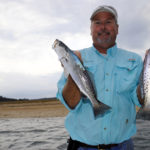
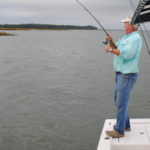
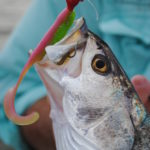
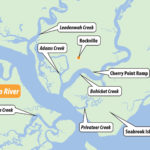




Be the first to comment